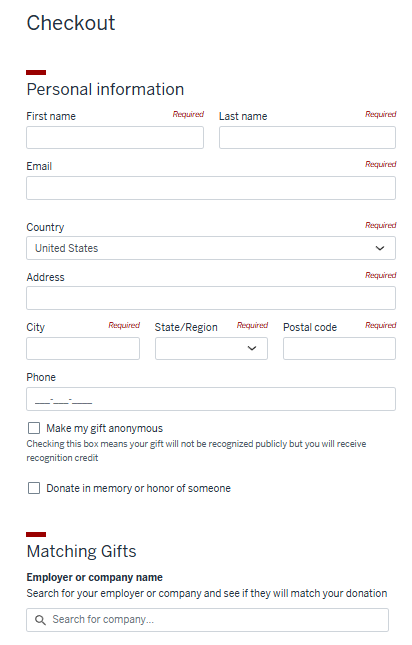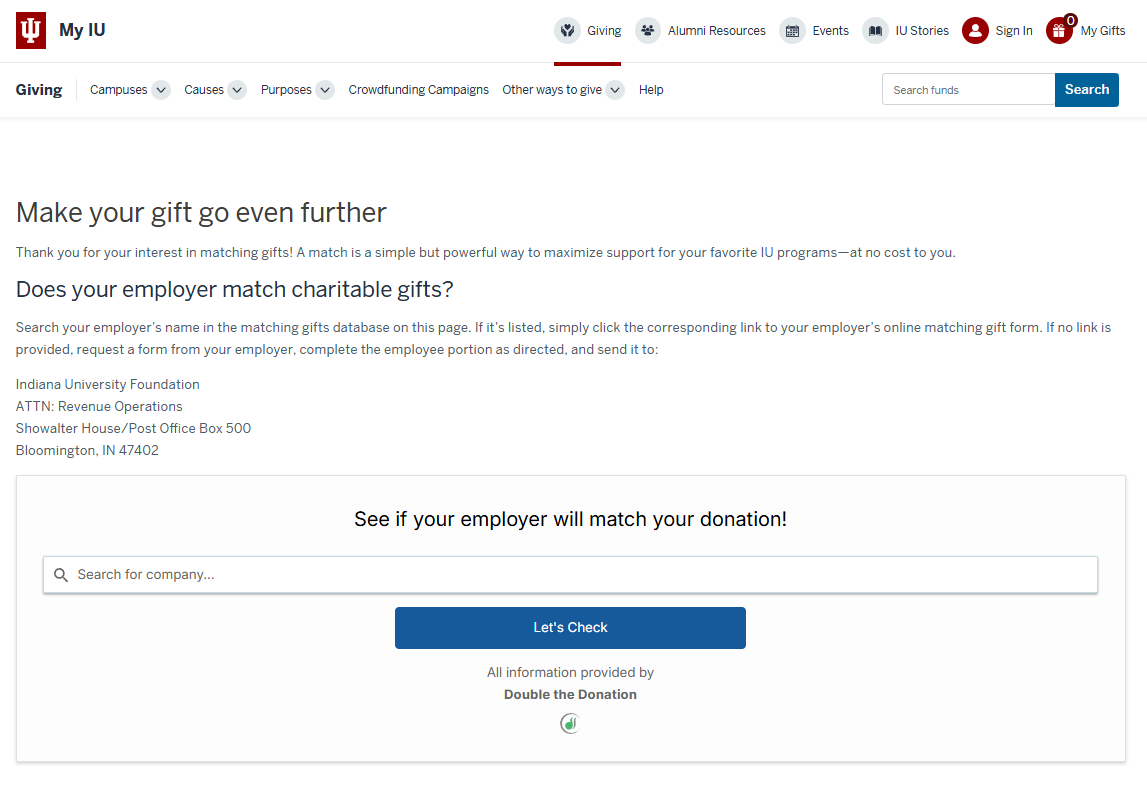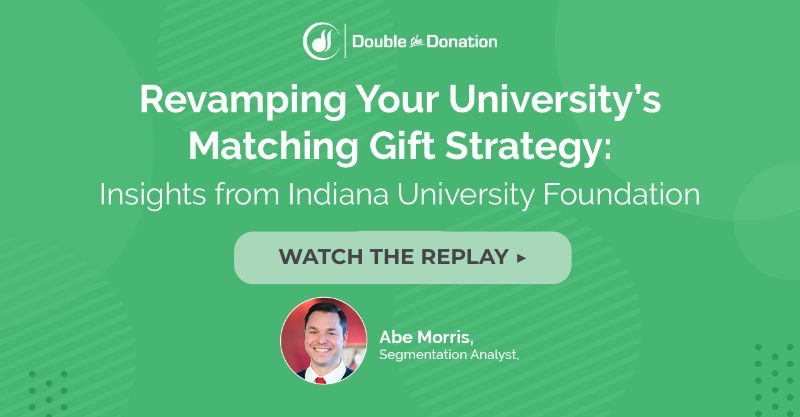College development groups are at all times in search of methods to extend donor impression and construct stronger relationships with alumni and supporters. One of the efficient—however typically underused—instruments is matching items. In the event you’re in search of methods to revamp your college’s matching reward technique, you’ve come to the suitable place.
In a current webinar, we sat down with Abe Morris of the Indiana College Basis (or IUF) to debate the varied methods through which their crew optimized its method to matching items—streamlining processes, bettering donor engagement, and maximizing income. As he spoke, we discovered that one of many first objects Abe was tasked with, upon starting his new function at IUF in 2022, was to try their matching reward program and see what he might do to enhance it. They began with a single, quarterly piece of junk mail selling matching items, so outreach was rare and single-channel, with a whole lot of room to develop. And develop they did!
Thinking about viewing the complete presentation? Take a look at the replay right here. In any other case, let’s stroll by way of an summary of the steps the crew took to revamp their college’s matching reward technique.
Conducting an ROI evaluation
Step one in refining the matching reward technique was a radical return on funding (ROI) evaluation—a crucial transfer to raised perceive the present state of matching reward participation and determine areas for development. This evaluation concerned digging into current donor knowledge to guage key metrics equivalent to:
- The entire quantity of particular person giving
- How a lot of that giving was being matched by employers
- The completeness and accuracy of employer data within the database
- The match eligibility charge amongst identified donors
Two necessary insights emerged from this deep dive. First, employer knowledge was typically incomplete or lacking, making it tough to determine match-eligible donors. Second, even amongst donors whose employers had been confirmed to supply matching reward packages, many had been not submitting match requests. This revealed a big hole between potential and precise matching reward income.
In brief, the evaluation confirmed that there was untapped potential sitting within the donor base—{dollars} left on the desk merely because of lack of understanding, lacking knowledge, or course of gaps. By figuring out these inefficiencies early on, the crew might start focusing on particular alternatives to enhance knowledge high quality, educate donors, and drive extra match requests, finally maximizing income from matching items.
Setting objectives
To faucet into their full matching reward potential, the Indiana College Basis knew they wanted extra than simply good intentions. What they wanted was a transparent roadmap. That started with setting three targeted, strategic objectives designed to information their efforts and measure success over time.
1. Enhance donor consciousness of matching reward packages.
IUF acknowledged that many eligible donors merely weren’t making the most of their employer’s matching reward choices, actually because they didn’t know the packages existed. One in all their main objectives turned boosting consciousness by way of focused outreach, donor training, and well timed follow-ups.
By embedding matching reward messaging all through the giving journey—from donation types to thank-you emails—they aimed to maintain the chance entrance and heart.
2. Enhance the standard and amount of employment knowledge.
Incomplete or outdated employer data was one other main barrier to unlocking matching items. With out realizing the place donors labored, it was almost unimaginable to determine eligible matches.
So IUF set a second purpose: to gather and preserve extra correct employment data by way of strategies like donation type fields, electronic mail outreach, and knowledge append providers. The extra full their information, the higher they may personalize matching reward outreach and observe up successfully.
3. Enhance whole matching reward income.
Finally, all efforts had been tied to a bigger purpose: rising matching reward income in a sustainable and scalable means. By elevating consciousness and bettering knowledge, IUF positioned itself to seize extra matches—and to trace the monetary impression over time. This purpose served as each a measure of success and a motivating benchmark for your entire development crew.
Collectively, these three objectives created a stable basis for revamping IUF’s matching reward technique—turning what was as soon as a passive income stream into an energetic driver of philanthropic development.
Understanding the matching reward course of
Earlier than the Indiana College Basis might totally execute their matching reward technique, they wanted to deeply perceive how the method labored from begin to end. That meant mapping out the precise donor journey and figuring out the place alternatives had been being missed or delayed.
To do that, Abe collaborated intently with the income operations crew, digging into the mechanics of how matching items flowed into the group. This step was crucial—not only for optimizing inner workflows, but additionally for figuring out ache factors that had been impacting each donors and the college’s capability to safe matching funds.
Right here’s what they uncovered:
When a donor makes a present, a number of issues can occur. Typically, the donor is already conscious of their employer’s matching reward program and initiates a request on their very own. In different circumstances, nonetheless, the donor learns concerning the alternative by way of post-donation outreach—like emails, web site prompts, or follow-up reminders from the college.
As soon as the donor decides to pursue the match, they sometimes full a web based type by way of their employer’s portal. This type is then reviewed by their employer, who contacts the establishment (on this case, IUF) to confirm that the unique donation was made and that it meets the corporate’s matching standards.
After this verification step, both the employer or a third-party vendor—equivalent to a company social duty (or CSR) platform—processes the matching fee. The funds are despatched to the college and recorded within the development system as a matched reward.
This course of could sound easy, but it surely includes a number of stakeholders, timing dependencies, and knowledge handoffs. What stood out most on this evaluation was the significance of coordination—from clear communication with donors to well timed responses to employers, each step performs a job in securing the match.
Changing into conversant in frequent challenges
With a transparent understanding of the matching reward course of in hand, the following crucial step for the Indiana College Basis was to confront the realities of implementation—particularly, the frequent challenges that may hinder matching reward success. Anticipating these hurdles allowed the crew to construct a extra resilient and responsive technique.
One of many largest challenges? The irregularity of matching reward disbursements. Whereas some firms course of matches on a rolling foundation, others could solely challenge funds quarterly—and even simply yearly. This inconsistency makes it tough to forecast income and might delay when funds truly hit the books.
One other challenge is restricted visibility into matching reward achievement. Many firms use third-party distributors or CSR platforms (like Benevity, CyberGrants, or YourCause) to course of match funds. Whereas these programs assist streamline company giving on the employer’s aspect, they’ll create knowledge gaps for nonprofits. Funds could arrive with minimal figuring out data, making it tough to hyperlink the match again to the unique donor or reward.
Lastly, IUF needed to navigate company-specific restrictions on matching reward eligibility. Not all donations are handled equally, with some employers solely matching items made to particular varieties of packages, equivalent to analysis or scholar help. In the meantime, others explicitly exclude areas like athletics, with such nuances making it tough to trace and sometimes leaving donors confused or dissatisfied when their items don’t qualify.
Fortunately, by proactively figuring out these frequent challenges, IUF was in a position to handle expectations, educate donors extra successfully, and fine-tune inner programs to catch and reply to points earlier than they turned roadblocks. In different phrases, understanding the obstacles up entrance laid the groundwork for a extra strategic and sustainable matching reward program shifting ahead.
Benefiting from employer knowledge
As soon as the IUF had a clearer image of the challenges surrounding matching items, the following step was to optimize the info they already had—particularly, employer data. This required an in depth partnership with the development knowledge crew to determine how you can higher gather, handle, and activate that knowledge in ways in which would straight help matching reward efforts.
The primary main enchancment was integrating Double the Donation’s matching reward instrument into the college’s web site and donation types.


This resolution permits donors to simply seek for their employer through the giving course of and immediately uncover in the event that they’re eligible for an identical reward program. With the instrument embedded straight on the level of donation, IUF might proactively floor related matching reward data in actual time, as a substitute of counting on delayed outreach months later.
However the Basis didn’t cease there. To handle gaps in employer knowledge for current constituents, they started working with a knowledge processing and enrichment firm. By this partnership, they started to append employer data on an everyday, month-to-month foundation. This helped be sure that information had been frequently up to date with probably the most present employment particulars. Plus, it allowed IUF to determine match-eligible donors who may in any other case slip by way of the cracks.
Establishing an identical reward communication plan
With the suitable instruments and knowledge in place, the Indiana College Basis turned its consideration to an equally crucial part of a profitable matching reward technique: communication. The Basis knew that merely having the data wasn’t sufficient. They wanted to make sure it reached the suitable folks on the proper time, in a means that felt useful quite than overwhelming.
To perform this, IUF started to weave matching reward language into almost each related donor touchpoint. They built-in it throughout their communications ecosystem—from reward receipts and electronic mail follow-ups to donation types and social media adverts.


Every message was crafted with objective and readability, pointing donors to the college’s devoted matching items web page for extra data.


By establishing a complete, multi-channel communication plan, IUF elevated visibility for matching items, bolstered donor training, and considerably improved the probability that eligible supporters would observe by way of. It wasn’t nearly elevating consciousness—it was about making a constant, donor-friendly expertise that made taking motion really feel seamless.
Measuring and monitoring success
With new programs, instruments, and methods in place, IUF knew that ongoing success would hinge on one key issue: measurement. In the event that they couldn’t monitor the impression of their efforts, they couldn’t enhance them or display their worth to stakeholders.
To shut that loop, the crew prioritized constructing a devoted matching reward efficiency dashboard. This inner instrument was designed to observe real-time knowledge and supply a transparent view of progress towards their strategic objectives.
The dashboard targeted on a number of core metrics:
- Whole matching reward income — to measure the general monetary impression
- Variety of matching items acquired — to gauge engagement and donor participation
- Share of eligible donors who submitted matches — to evaluate the effectiveness of outreach and training
By evaluating KPIs over time, IUF might clearly see which initiatives had been working and the place there was room to develop. Simply as importantly, they had been in a position to tie these insights again to their authentic objectives. Growing donor consciousness, bettering knowledge high quality, and maximizing matching reward income.
Wrapping up & webinar replay
Matching items symbolize a significant alternative for universities—however solely when you’ve got the suitable technique in place. Success begins with donor training, environment friendly verification workflows, and robust collaboration between development groups and company companions.
By making use of these classes, your college can rework matching items from a passive afterthought into a robust fundraising engine. Begin small, keep constant, and watch your impression multiply.


